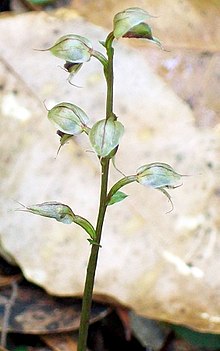
Acianthus, commonly known as mosquito orchids, is a genus of about twelve species of plants in the orchid family, Orchidaceae. Mosquito orchids are terrestrial herbs with a single, heart-shaped, usually ground-hugging leaf and one to many small, green, pinkish or purplish flowers on a fleshy stalk. They are found in New Caledonia, Australia and New Zealand.

Caladenia carnea, commonly known as pink fingers, is a plant in the orchid family Orchidaceae and is endemic to eastern and south-eastern Australia, including Tasmania. It has a single thin, green leaf and one to five white or pink flowers with red stripes and two rows of yellow-tipped "calli" on their labellum.
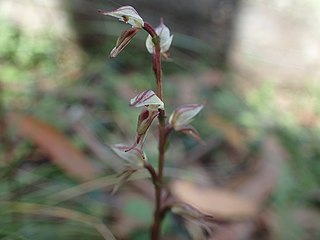
Acianthus apprimus, commonly known as early mosquito orchid, is a flowering plant in the orchid family Orchidaceae and is endemic to New South Wales in Australia. It is a terrestrial herb with a single, heart-shaped leaf and between two and nine translucent pinkish flowers with reddish markings and is found in disjunct populations around the state.
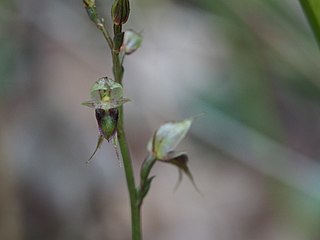
Acianthus exiguus, commonly known as tiny mosquito orchid, is a flowering plant in the orchid family Orchidaceae and is endemic to New South Wales in Australia. It is a terrestrial herb with a single, heart-shaped leaf and up to five translucent greenish-white flowers with pinkish markings and is found growing in forests on the north coast of the state.

Acianthus exsertus, commonly known as gnat orchid or large mosquito orchid, is a flowering plant in the orchid family Orchidaceae and is endemic to eastern Australia. It is a terrestrial herb with a single, heart-shaped leaf and up to 25 small, fine, dark brown flowers with pinkish and purplish markings and is found growing in sheltered places in forests in Queensland, New South Wales the ACT and Victoria.

Caladenia congesta, commonly known as black-tongue caladenia, is a plant in the orchid family Orchidaceae and is endemic to Australia. It is a ground orchid with a single, sparsely hairy leaf, and up to three bright pink flowers with the central part of the labellum completely covered with black calli. It is a widespread species but not common in any part of its range.

Caladenia testacea, commonly known as honey caps, or honey caladenia is a plant in the orchid family Orchidaceae and is endemic to New South Wales. It is a ground orchid with a single, sparsely hairy leaf and up to three white to yellowish-green flowers with brownish tips and a darker back.

Caladenia minorata, commonly known as the small waxlip orchid, is a plant in the orchid family Orchidaceae and is endemic to eastern Australia. It is a ground orchid with a single very hairy leaf and one or two deep violet-blue flowers. It has been known as Glossodia minor since its description by the prolific Scottish botanist Robert Brown in 1810, but recent discoveries suggest its inclusion in the genus Caladenia. It is similar to Caladenia major but is smaller in all its parts.
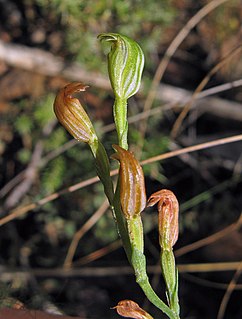
Pterostylis parviflora, commonly known as the tiny greenhood, is a species of orchid endemic to south-eastern Australia. As with similar orchids, the flowering plants differ from those which are not flowering. The non-flowering plants have a rosette of leaves but the flowering plants lack a rosette at the base but have up to eight tiny green, white and brown flowers.

Pterostylis squamata, commonly known as the southern rustyhood or ruddyhood, is a plant in the orchid family Orchidaceae and is endemic to south-eastern Australia. Flowering plants have up to ten translucent green flowers with reddish-brown markings and a hairy, insect-like labellum. Non-flowering plants have a rosette of four to eight egg-shaped leaves. This species is very similar to Pterostylis rufa which has a narrower labellum and other minor differences.
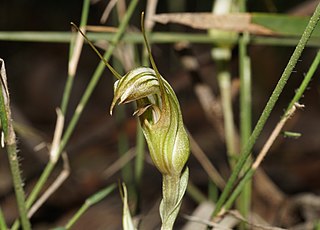
Pterostylis ophioglossa, commonly known as the snake-tongue greenhood, is a species of orchid endemic to eastern Australia. It has a rosette of leaves at the base and a single dull green, white and brown flower with a deeply notched labellum.

Pterostylis reflexa, commonly known as the dainty greenhood, is a species of orchid endemic to New South Wales. As with similar greenhoods, the flowering plants differ from those which are not flowering. The non-flowering plants have a rosette of leaves flat on the ground but the flowering plants have a single flower with leaves on the flowering stem. This greenhood has a relatively large white, green and light brown flower with a long, curved dorsal sepal and a protruding labellum.
Prasophyllum australe, commonly known as the southern leek orchid or austral leek orchid, is a species of orchid and is endemic to south-eastern Australia. It has a single tubular, green leaf and up to fifty scented, greenish-brown flowers with red stripes.
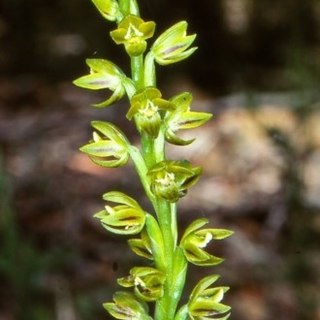
Prasophyllum flavum, commonly known as the yellow leek orchid, is a species of orchid endemic to eastern Australia. It has a single tubular, green leaf with only a short free section and up to fifty scented, yellowish-green flowers.
Prasophyllum gibbosum, commonly known as the humped leek orchid, is a species of orchid endemic to the south-west of Western Australia. It is a late-flowering leek orchid with a single smooth, tubular leaf and up to eighty or more purplish-red and white flowers with a smooth labellum. It is similar to P. cucullatum but that species has a frilly labellum, usually a shorter flowering stem and an earlier flowering period.

Acianthus caudatus, commonly known as the mayfly orchid, is a flowering plant in the orchid family Orchidaceae and is endemic to eastern Australia. It is a terrestrial herb with a single egg-shaped or heart-shaped leaf and up to nine dark purplish flowers with thin, spreading sepals and petals, often with a musty odour.
Genoplesium rufum, commonly known as the rufous midge-orchid, is a species of orchid endemic to New South Wales. It has a single thin, wiry leaf and up to twenty five drooping, pinkish or reddish flowers on a flowering stem which is fused to the lower part of the leaf. It was formerly thought to range from Queensland to South Australia and Tasmania but specimens in other states are now assigned to Genoplesium clivicola.
Corunastylis nigricans, commonly known as the Kangaroo Island midge orchid is a small terrestrial orchid endemic to South Australia. It has a single thin leaf and up to twenty five purplish brown flowers with a shiny, hairless, dark purplish labellum. It is sometimes confused with Genoplesium nigricans which has differently coloured flowers and a much wider distribution. It is regarded as a synonym of G. nigricans by the World Checklist of Selected Plant Families.
Genoplesium baueri, commonly known as the brittle midge orchid, is a small terrestrial orchid which is endemic to New South Wales. It has a single thin leaf and up to nine yellowish green to reddish brown flowers. It is mostly only found in coastal and near-coastal heath and woodland between Port Stephens and Ulladulla.

Corybas fimbriatus, commonly known as the fringed helmet orchid, is a species of terrestrial orchid endemic to eastern Australia. It has a broad egg-shaped to round leaf and a dark reddish purple to crimson flower with translucent patches. It is similar to C. hispidus but its labellum lacks a creamy-white centre and is not covered with bristly hairs.
